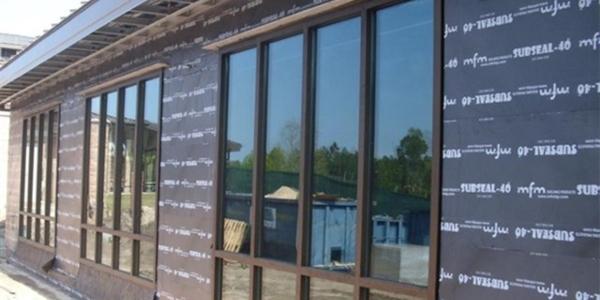How to keep parapet walls waterproof
May 21, 2025 at 6:00 p.m.By Jesse Sanchez.
A solid waterproof membrane is your best defense against parapet wall failure — here’s what to know before you install.
Parapet walls are among the most vulnerable parts of a building’s envelope when it comes to water damage. Positioned at the outermost edges of a roof and exposed from nearly every direction, they bear the brunt of weather’s wear-and-tear. According to MFM Building Products Corp., this exposure means they “fail more often than other parts of the roof.”
Waterproofing a parapet wall isn’t as simple as putting on a membrane — it’s a precision job that depends on the wall’s materials, the building's design and the membrane’s physical properties. In a prior guide, MFM outlines best practices for contractors and architects looking to protect these critical roof elements from water intrusion.
The company strongly recommends using membranes that meet ASTM D 1970 and E 331 standards, which ensure sufficient nail sealability and weather resistance. “This minimum thickness [40 mils] provides a robust membrane and a solid waterproofing foundation,” according to MFM.
Different wall finishes call for different solutions. If the parapet will be capped with metal, high-heat resistance is non-negotiable. MFM warns that failing to use heat-rated membranes — such as those rated to 250°F — can cause mastics to melt, compromising the entire waterproofing layer.
For masonry applications like brick or stucco, vapor permeance becomes a priority. Membranes that meet ASTM E 96 are designed to withstand constant moisture exposure, helping prevent breakdown over time.
Installation plays just as critical a role. MFM provides layering techniques, such as starting with a 12-inch membrane at the roof-to-wall intersection and topping it with a full-width 36-inch sheet. This method reduces the chance of water penetration where leaks are most likely to occur.
Overlaps, too, require precision. “Always overlap membranes by a minimum of three inches,” the guide says and ensure that water flows over the seams, not against them.
Priming the surface and using a hand roller to press the membrane down are final steps that shouldn’t be skipped, especially when dealing with older or porous masonry surfaces.
While MFM’s guide is filled with practical how-to's, it leaves plenty for the reader to consider when choosing the right product and method for their own project. Waterproofing parapet walls isn't just a box to check — it’s a critical investment in a building’s long-term durability.
Read the full guide, including product-specific recommendations and detailed diagrams!
Learn more about MFM Building Products Corp. in their Coffee Shop Directory or visit www.mfmbp.com.

About Jesse
Jesse is a writer for The Coffee Shops. When he is not writing and learning about the roofing industry, he can be found powerlifting, playing saxophone or reading a good book.
Recommended For You

Diversifying to meet the growing needs of roofers
Read More ...
Polyglass Publishes New E-Newsletter for Roofing Professionals
Read More ...
Shop, swipe and earn
Read More ...


















Comments
Leave a Reply
Have an account? Login to leave a comment!
Sign In